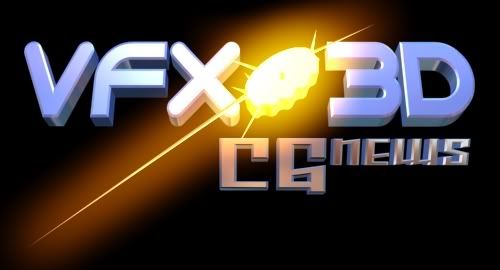T-Splines Announces T-Splines Maya Plugin Modeling Software
Provides greater control and more efficient modeling for animation and industrial design
T-Splines, LLC, leading developer of 3D animation modeling software, announced today that the T-Splines Maya plugin 1.0 is now shipping, opening a new frontier in 3D modeling by solving two problems that have plagued the 3D modeling industry since its inception: greater surface control and seamless merging. A free trial of the T-Splines Maya plugin Learning Edition may be downloaded at the T-Splines website, http://www.tsplines.com.
The innovative plugin, which integrates easily with NURBS and polygons, allows artists to add single control points anywhere on a 3D surface without changing the surface. The plug-in also solves a major industry problem by allowing surfaces to merge seamlessly, resulting in greater control, less tedium, and much faster and efficient modeling for animation , industrial design and bioengineering professionals.
"T-Splines will give studios and designers a boost in productivity by reducing time spent designing and by presenting superior animation ." said Matt Sederberg, co-founder and CEO. "We are dedicated to making T-Splines the next industry modeling standard in animation and CAD. The T-Splines Maya plugin truly represents the future of 3D modeling."
T-Splines is solving the next billion-dollar problem in the 3D modeling industry by eliminating gaps between objects, which until now has been a serious hindrance to the modeling process.
T-Splines allows animators, CAD engineers and others involved in 3D modeling and animation to:
* Reduce large amounts of data in existing models by removing superfluous control points from NURBS models
* Utilize T-Spline patches to create one seamless T-Spline model-with no gaps between objects!
* Make changes to 3D models more quickly
* Render faster
* Significantly improve modeling productivity in Maya
* Import any NURBS object into T-Splines
* Insert NURBS-compatible local creases
* Quickly create models that can be fully animated
"Over the years I've witnessed and been apart of the significant growth in the 3D animation field and the evolving technology surrounding it," said R. Brent Adams, head of the animation department at Brigham Young University. "Having worked with NURBS and other applications, I feel that T-Splines will take animators to the next level by boosting productivity and control in a way that has not yet been seen in the industry."
About T-Splines
T-Splines, LLC was founded in 2004 by Matt Sederberg and Tom Sederberg. Based on several years of research and development, Dr. Tom Sederberg invented the T-Spline technology. This solution opens up new frontiers of modeling possibilities, allowing artists and designers to add detail and merge models in ways that were previously difficult at best. The Maya plugin is compatible with existing modeling capabilities and provides additional benefits including greater surface control and seamless merging for more efficient modeling in the animation , industrial design and bioengineering fields. T-Splines is located in Lindon, Utah.
For more information visit www.tsplines.com.
T-Splines, LLC, leading developer of 3D animation modeling software, announced today that the T-Splines Maya plugin 1.0 is now shipping, opening a new frontier in 3D modeling by solving two problems that have plagued the 3D modeling industry since its inception: greater surface control and seamless merging. A free trial of the T-Splines Maya plugin Learning Edition may be downloaded at the T-Splines website, http://www.tsplines.com.
The innovative plugin, which integrates easily with NURBS and polygons, allows artists to add single control points anywhere on a 3D surface without changing the surface. The plug-in also solves a major industry problem by allowing surfaces to merge seamlessly, resulting in greater control, less tedium, and much faster and efficient modeling for animation , industrial design and bioengineering professionals.
"T-Splines will give studios and designers a boost in productivity by reducing time spent designing and by presenting superior animation ." said Matt Sederberg, co-founder and CEO. "We are dedicated to making T-Splines the next industry modeling standard in animation and CAD. The T-Splines Maya plugin truly represents the future of 3D modeling."
T-Splines is solving the next billion-dollar problem in the 3D modeling industry by eliminating gaps between objects, which until now has been a serious hindrance to the modeling process.
T-Splines allows animators, CAD engineers and others involved in 3D modeling and animation to:
* Reduce large amounts of data in existing models by removing superfluous control points from NURBS models
* Utilize T-Spline patches to create one seamless T-Spline model-with no gaps between objects!
* Make changes to 3D models more quickly
* Render faster
* Significantly improve modeling productivity in Maya
* Import any NURBS object into T-Splines
* Insert NURBS-compatible local creases
* Quickly create models that can be fully animated
"Over the years I've witnessed and been apart of the significant growth in the 3D animation field and the evolving technology surrounding it," said R. Brent Adams, head of the animation department at Brigham Young University. "Having worked with NURBS and other applications, I feel that T-Splines will take animators to the next level by boosting productivity and control in a way that has not yet been seen in the industry."
About T-Splines
T-Splines, LLC was founded in 2004 by Matt Sederberg and Tom Sederberg. Based on several years of research and development, Dr. Tom Sederberg invented the T-Spline technology. This solution opens up new frontiers of modeling possibilities, allowing artists and designers to add detail and merge models in ways that were previously difficult at best. The Maya plugin is compatible with existing modeling capabilities and provides additional benefits including greater surface control and seamless merging for more efficient modeling in the animation , industrial design and bioengineering fields. T-Splines is located in Lindon, Utah.
For more information visit www.tsplines.com.








